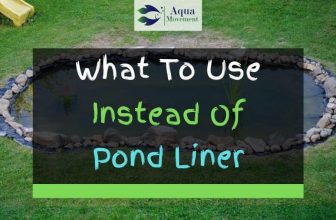4 Different Types of Pond Algae (With Pictures)
Algae can disrupt the peace and balance of your pond in a number of ways.
First of all, they can make what was once a very aesthetically pleasing feature of your garden into an absolute eyesore.
This could be the ultimate wound for any self-respecting pond owner. What’s more, the crimes don’t stop there.
Algae will inevitably compete with other aquatic forms of fauna and flora for the limited resources of your pond, and because they can grow and proliferate so quickly, they can usually win this competition for resources.
Unfortunately this can lead to dissolved oxygen levels falling to unsustainably low levels in your pond. causing the fish and other creatures to potentially die.
Algae can also create a host of harmful by products and unexpected side effects.
There are lots of different types of algae (in fact there are more than a million distinct species) that can affect your precious pond, and in this comprehensive article we will address all the major types of pond algae.
Table of Contents
What is Algae?
Before you can get down to the important work of identifying exactly what kind of algae you have in your pond, you need to understand a little bit of the fundamentals about what algae is.
Algae usually consist of fully photosynthetic, aquatic creatures from the protista kingdom, but within that wider group there is huge scope for diversity.
For example, algae can range from tiny, micrometer scaled organisms to huge, towering kelp weeds.
The species can also range from very simple, single cell organisms to complex, developed organisms as complicated as any plant or animal.
They differ from other aquatic plants both because they lack roots and they can multiply and propagate at extremely fast rates.
Because they are photosynthetic, they are usually (though not always) some shade of green, and they use sunlight to gain energy for activity.
As a result, most species are most active and rampant in conditions of strong direct sunlight.
Algae is usually considered only to be the unattractive, scum like covering on a pond or lake, but it can crop up in many other forms as well.
Green Water Algae

Green Water Algae is one of the most common types of pond algae found in domestic ponds all over the world.
Upon discovering too much of this pernicious breed of algae you should act quickly to eradicate the problem before your pond is swamped.
However, in small amounts this type of algae is relatively harmless and as a matter of fact it is found in most healthy aquatic ecosystems.
In terms of appearance this form of pond algae is very recognizable. They are very small bodies, and contain chloroplasts which gives them their distinctive bright green color.
They can provide a bountiful source of food and energy for smaller omnivorous fish who are near the bottom of the food chain.
They are generally an essential part of the equilibrium of a garden pond, taking in some of the nutrients in the water and producing some more of their own.
As eluded to earlier, usually this is not much of an issue. However, when the nutrients levels in a pond rise suddenly the population of this type of algae can boom, leading to a condition known as ‘eutrophication’.
This will become obvious as the water turns green and an unappealing green film may form on the surface of the water.
This can greatly deplete the precious oxygen levels in the pond, ultimately leading to inevitable death and destruction.
Green algae thrive in direct sunlight and in warm waters, so summer can be a particularly troublesome period for dealing with these types of pond algae.
String Algae (Filamentous Algae)
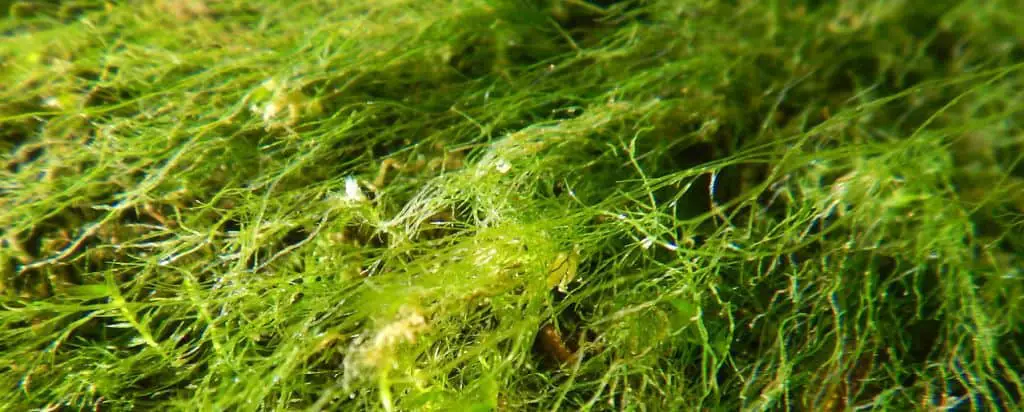
Another one of the types of pond algae that can be a real bother to the modern pond owner is filamentous algae.
This is also known as string algae, and when you see it the reason for its name becomes obvious.
This type of algae links together to for long fibers or strings of algae which can be very unattractive in an aquatic setting.
In the scientific sense, this type of algae belongs to the chlorophyta family and is therefore typically green in color, but may also be found in shades of yellow or even brown.
There are numerous sub groups of filamentous algae, some of the ones you may be aware of are water silk, blanket weed or horse hair algae.
This type of algae consists of extremely simple single celled organisms that can join together to form the long strings, and can even overlap to form dense, thick mats. This can cause numerous problems for the intrepid pond owners.
Not only those this type of algae block sunlight from reaching the water below and deplete the level of dissolved oxygen in the water, but it also can clog filters and pumps in outdoor ponds.
It is an essential source of energy and nutrients for lots of small fish and aquatic creatures, especially young spawn, but the consequences of it getting out of control could be very serious indeed.
It immediately damages the appearance of your pond, as well as the all-important water quality.
Planktonic Algae
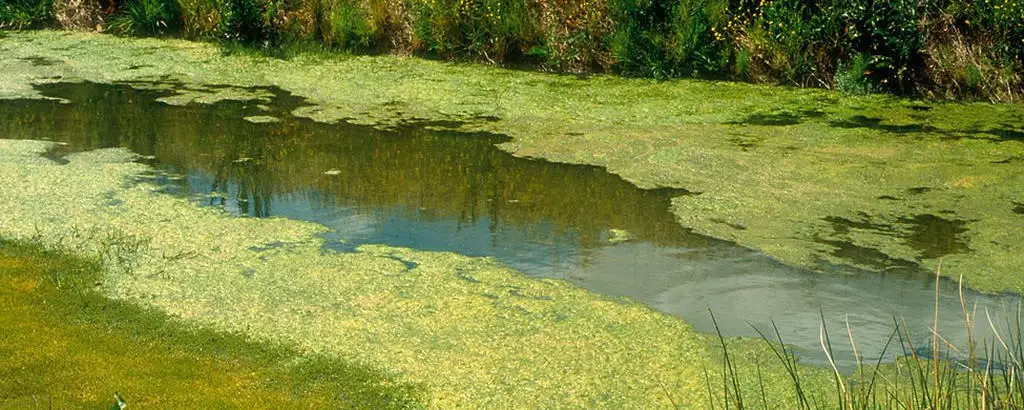
Planktonic algae is the opposite of the filamentous pond algae mentioned in the paragraph above. It is a type of microscopic floating vegetation, that can be especially pernicious.
One of the major problems with this type of pond algae is that because the algae is so small, you may not notice this before it experiences a population explosion and becomes a massive problem overnight.
Planktonic algae is technically a term applied to a large group of different algae species, so there is a huge variety in color and conditions with this type of algae.
For example, although most species are green in color, they can also be blue, brown or variations thereof.
Like most of the other species, this type of algae is only a problem in large amounts.
In fact, in small amounts it can have a very beneficial impact on the ecosystem. This is because it forms the very base of the food chain, and smaller fish and other aquatic critters can consume it to get a vital supply of energy.
If it is allowed to grow to uncontrolled proportions however, that is when the real problems of water chemistry and oxygen depletion start to kick in.
Blue Green Algae (Cyanobacteria)
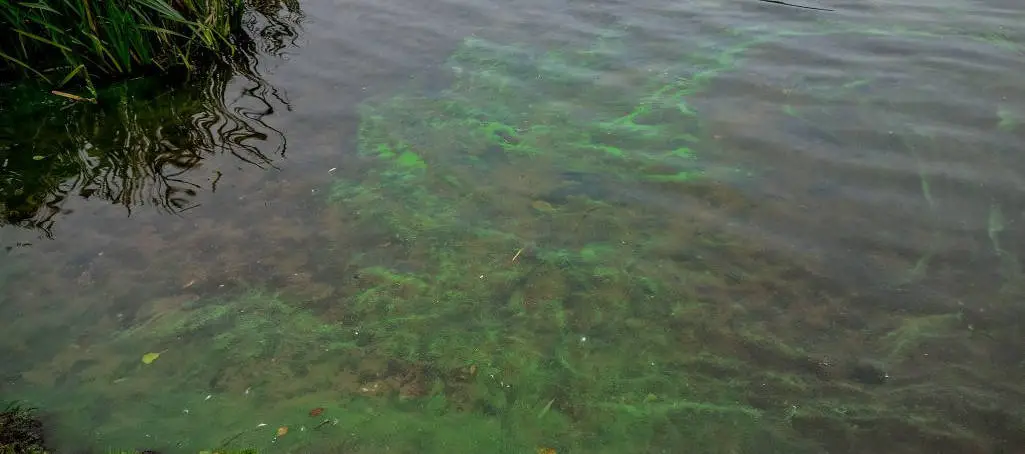
Blue Green Algae (part of the planktonic algae group) is not a true type of algae, but it has a similar appearance as aquatic algae and can have the same devastating impact, and as such it is usually classed among them. It is actually a type of bacteria, which has a blue green tinge to it.
It generally forms in thick, slimy mats and may often stick together quite tightly. It can survive both in internal fish tanks and often externally in garden ponds, but in very different conditions to those that attract green algae.
It tends to like to attach itself to surface such as rocks or the substrate of the pond, but in other circumstances it may rise to the surface.
It may also grow around other driftwood and aquatic plants in the pond, and can be fiercely competitive for resources with them.
Cyanobacteria
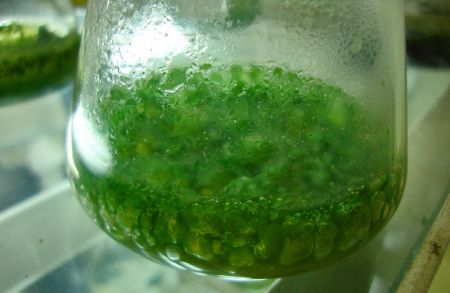
One of the giveaway signs of blue-green algae (or cyanobacteria as it is more properly known) is the unpleasant odor it produces.
This along with the dead or dying fish caused by a cyanobacteria bloom can lead to a truly nightmarish scene for any passionate pond owner.
Cyanobacteria are often toxic to fish and other aquatic creatures in your pond. This could have very dire consequences if they decide to snack on the algae.
In fact, they can be so toxic that you should use gloves if you’re going to go near cyanobacteria infected waters.
One of the things that cyanobacteria do, as well as using up precious dissolved oxygen resources, is causes chemical levels in the pond to go totally out of balance.
Usually, nitrogen cycling in a pond, as performed by good, helpful bacteria and natural biological filtration, can help to keep certain harmful substances (arising from fish waste) down to low levels.
But during a cyanobacteria bloom, these ammonia and nitrate levels for example may rise to greatly unhealthy levels, having knock on effects on your fish’s health and general well-being.
Unfortunately, chemical treatments are often needed to get rid of a nasty cyanobacteria bloom, (such as the use of antibiotics or hydrogen peroxide), but this can have harmful effect on the good bacteria in your pond, and the overall ecosystem.
Video: “Algae Corner: How to Identify Different Algae Types”
Dealing with Different Types of Pond Algae
Although there are a great multitude of algae types, and even more varieties of algae within these types, there are some common means and methods to deal with this menace.
Scraping
First of all, the most basic option once you notice an algae bloom will be manual scraping. This is a mechanical solution which involves you donning gloves and getting down and dirty with the algae.
You should invest in a skimmer to reach less accessible parts of the pond.
This will greatly improve the appearance of your pond, but you should be aware that no matter how thorough you are with your cleaning, you will not remove all traces of the algae.
Furthermore, this process will do nothing to deal with the root causes of the algae bloom.
Chemical Treatment
A better option may be chemical treatment of your pond water.
This is a more thorough solution which will target the basis of the algae growth, but you should know that this route is not without risk.
This could inadvertently damage other, beneficial bacteria in your pond, and this could have very dramatic knock on effects on the ecosystem.
For example, this could disrupt the nitrogen cycle in your pond, or throw the ammonia or other nutrient levels in your pond out of equilibrium. Use this option with caution and expert guidance.
Prevention
The best option for dealing with pond algae is to prevent it in the first place.
There is a number of effective measures to help you do this. For instance, it has long been known that adequate filtration is needed to help keep down algae growth in ponds.
This should consist of strong biological and mechanical filtration at least, and you may want to pursue chemical options as well.
Aeration is also keen to keeping your ecosystem healthy and relatively free of algae. You can help this by installing pumps or other aquatic plants.
In general plants will help to keep the level of algae down by competing with them for the limited resources.
Finally, make sure that you are not overfeeding your pond fish. This will lead to an excess of nutrients accumulating in your pond from uneaten food which falls to the bottom.
This makes the perfect conditions for algae to thrive.
A good rule of thumb is to not feed your fish anymore than they can consume in a few minutes and remove any uneaten scraps at the end.
Conclusion
There are so many different types of pond algae out there in the world. In this article we have explored some of the most common types which are found in garden ponds all around the world.
For example, cyanobacteria, green algae, filamentous algae and planktonic algae should be well known to any experienced aquatic horticulturist.
These all have distinctive appearances and conditions in which they thrive, but in many respects the net results of an algae bloom are the same.
They will cause oxygen depletion, block sunlight from the water below, and throw your carefully tended ecosystem completely out of balance.
This should be considered beforehand, and you should take preventative measures to avoid it.


